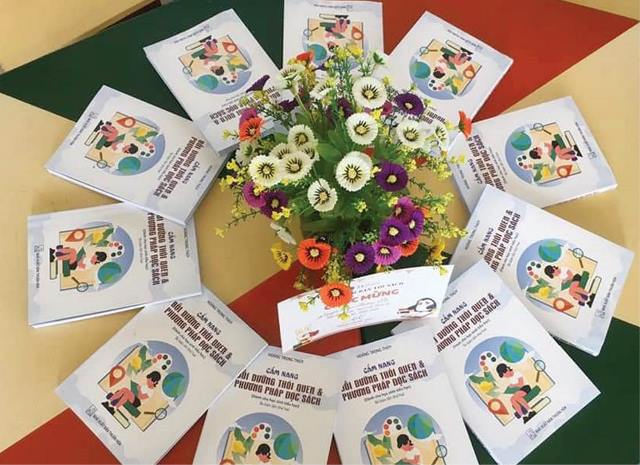
Hoang Trong Thuy, the author
Read Methodically
The book set includes two handbooks, one for elementary students and another for secondary school students. The handbook for elementary students consists of three parts. Part 1: "Cultivating interest & reading habits" includes articles on the benefits and effects of reading on intellectual development, personality formation as well as methods for developing reading habits. Through these articles, students can understand the purpose and meaning of reading books so as to keep self-motivated.
Part 2: “A guide to practicing reading” provides instructions on the procedures and methods of effective reading, ranging from choosing books, reading, taking notes, sharing information and practicing.
Part 3: “Practicing reading” instructs students the ways to practice reading more effectively through eliciting questions about things of interest, contents, characters, situations, etc. “Reading logs” also helps children develop the habit of taking notes while reading, as well as listing and reckoning up the number of books that they have read within a month or a year.
Post-reading practice forms for taking notes and sharing are designed in a variety of ways, ranging from easy level to difficult one. After reading, children can choose any book and form in which they feel interested to start practicing.
“Test your skills” encourages children to try inventing a different ending for their favorite story so as to spark their imagination. The "Recommended reading list" near the end of the handbook lists books carefully selected by the author which cover many different topics for students to refer to when choosing books.

The "Handbooks for Fostering Reading Habits & Methods of Reading" bringing an effective reading method to students
Similar to the handbook for elementary students, the “Handbook for Fostering Reading Habits & Methods of Reading” for secondary school students also helps them better understand the values and effects of reading, introduces reading procedures, provides practice forms which help students practice thinking and summarizing after reading more conveniently.
However, there are more advanced practical methods in order to stimulate students’ thinking, such as the application of focused thinking methods when writing a reflection, generalizing the contents, feelings and findings while reading, or drawing lessons from the book, etc.
Honing skills
On free days due to social distancing during the COVID-19 pandemic in 2020, Mr. Hoang Trong Thuy embarked on writing his long-cherished "Handbooks for Fostering Reading habits & Methods of Reading". The handbooks share his experience which has been drawn after more than 13 years of implementing the program "Make friends with book" organized by the Zhi-Shan Foundation to nurture and spread the reading culture among students. Before publishing, Mr. Thuy had sent the book to Education Departments for comments.
According to Mr. Thuy, reading books is ultimately a method of self-study and self-improvement. It should not be a temporary, phased activity but a lifelong learning method.
Despite its importance, the majority of students read books quite spontaneously and randomly without any methods. As a result, they can remember and apply very little despite reading a lot. Read methodically will help students get oriented as soon as they read and know how to condense what they have read.
“During my childhood, I couldn’t afford to read many books. It was not until I entered university that I got exposed to books. Initially, I read without knowing how to extract information. So, even though I read a lot, it wasn’t effective since I could take in very little information and knowledge. During the process of carrying out the activities to bring books to schools, I have gathered methods of reading books more methodically and systematically, and have introduced them into the handbooks for students," said Mr. Hoang Trong Thuy.
Without a method, it was not until one finish reading can they realize that they don’t need the book. The handbooks provide children with the criteria to choose the right book through surveying the title, table of contents, abstract, etc. The questions in the handbooks also help them know how to extract information, while at the same time eliciting issues for students to practice their critical thinking and reading skills, thereby helping them develop their language proficiency as well as speaking and writing fluency.
According to Mr. Thuy, in order to read books effectively, children need to read with purpose. For elementary students, parents should orient their offspring to read stories of good examples to cultivate their interest. Meanwhile, secondary school students should focus on deeper topics about history, literature, etc. Parents also need to foster the reading habits for their children from preschool or elementary school age.
Story and photos: Minh Hien